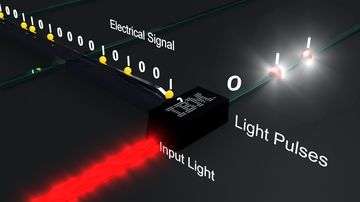IBM using light instead of wires for building supercomputers-on-a-chip

Supercomputers that consist of thousands of individual processor "brains" connected by miles of copper wires could one day fit into a laptop PC, thanks in part to a breakthrough by IBM scientists announced today.
And while today’s supercomputers can use the equivalent energy required to power hundreds of homes, these future tiny supercomputers-on-a-chip would expend the energy of a light bulb.
In a paper published in the journal Optics Express, the IBM researchers detailed a significant milestone in the quest to send information between multiple cores -- or “brains” -- on a chip using pulses of light through silicon, instead of electrical signals on wires.
The breakthrough -- known in the industry as a silicon Mach-Zehnder electro-optic modulator -- performs the function of converting electrical signals into pulses of light. The IBM modulator is 100 to 1,000 times smaller in size compared to previously demonstrated modulators of its kind, paving the way for many such devices and eventually complete optical routing networks to be integrated onto a single chip. This could significantly reduce cost, energy and heat while increasing communications bandwidth between the cores more than a hundred times over wired chips.
“Work is underway within IBM and in the industry to pack many more computing cores on a single chip, but today’s on-chip communications technology would overheat and be far too slow to handle that increase in workload,” said Dr. T.C. Chen, vice president, Science and Technology, IBM Research. “What we have done is a significant step toward building a vastly smaller and more power-efficient way to connect those cores, in a way that nobody has done before.”
Today, one of the most advanced chips in the world -- IBM’s Cell processor which powers the Sony Playstation 3 -- contains nine cores on a single chip. The new technology aims to enable a power-efficient method to connect hundreds or thousands of cores together on a tiny chip by eliminating the wires required to connect them. Using light instead of wires to send information between the cores can be 100 times faster and use 10 times less power than wires.
“We believe this is a major advancement in the field of on-chip silicon nanophotonics,” said Dr. Will Green, the lead IBM scientist on the project. “Just like fiber optic networks have enabled the rapid expansion of the Internet by enabling users to exchange huge amounts of data from anywhere in the world, IBM’s technology is bringing similar capabilities to the computer chip.”
IBM's optical modulator performs the function of converting a digital electrical signal carried on a wire, into a series of light pulses, carried on a silicon nanophotonic waveguide. First, an input laser beam is delivered to the optical modulator, which acts as a very fast “shutter” which controls whether the input laser is blocked or transmitted to the output waveguide. When a digital electrical pulse arrives from a computer core to the modulator, a short pulse of light is allowed to pass through at the optical output. In this way, the device “modulates” the intensity of the input laser beam, and the modulator converts a stream of digital bits (“1”s and “0”s) from electrical signals into light pulses.
The report on this work, entitled “Ultra-compact, low RF power, 10 Gb/s silicon Mach-Zehnder modulator” by William M. J. Green, Michael J. Rooks, Lidija Sekaric, and Yurii A. Vlasov of IBM’s T.J.WatsonResearch Center in Yorktown Heights, N.Y. is published in Volume 15 of the journal Optics Express. This work was partially supported by the Defense Advanced Research Projects Agency (DARPA) through the Defense Sciences Office program “Slowing, Storing and Processing Light”.
Video: www.youtube.com/watch?v=LU8BsfKxV2k
Source: IBM





















